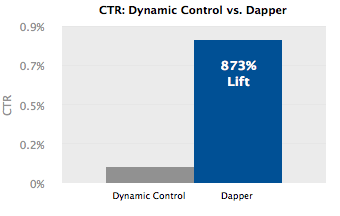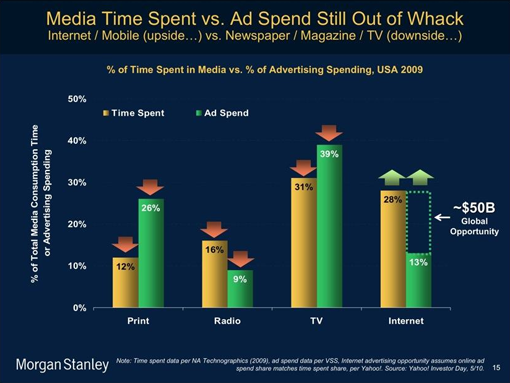This post is also available in: Russian
Today’s online advertising market has been mostly developed. It consolidates many players and operates large money flows. It generates most of the profits of many Internet companies including largest ones like Google and Yahoo. But its growth potential is still very big because of currently happening shift of audiences from legacy media to the net that we are seeing now. And advertisers follow their audience. Online advertising technologies are constantly moving also. All these things that changed the way we interact with the web recently, social networks, smartphones, online video, impact Internet advertising too. New more effective ways to deliver marketing message appear and force out of the market old methods and their followers. In this article we will try to go deeper into these trends.
- Location Based Services are not new, but recent advances in tech can give a new rise to them. Popularity of GPS-capable smartphones, growth of number of social networks users, geolocation services built in new generation of web browsers. All this will enable businesses to locate their customers more precisely. Using this information we can for example guide the customer to the nearest ATM, or service-centrer, or store.
Advertisers today have practically unlimited access to publishers through ad exchanges. This made their interest shift more from buying ad placements to buying specific audiences. Knowing customers location can greatly help to sort out target audiences. Location-based targeting successfully works in search results ads and now such companies as Local.com, LinkedIn, Facebook start offering geotargeting along with demographic and keyword targeting.
- Dynamic Creatives are another rapidly growing trend. Usually an advertising campaign features showing a fixed set of ad creatives. Dynamic ads are constructed dynamically from a template which has placeholders that are filled with information about specific product from advertiser’s inventory that can be potentially the most interesting to a customer currently watching the ad. The product is chosen based on targeting information or current web page context. This approach combined with retargeting users who already showed interest in the product before can push users who haven’t decided to buy yet into buying the product.
Another interesting approach to dynamic ads utilizes Pixazza. This company developed a technology that allows to advertise any products that are depicted on some picture on the web. For example, you are reading an entertainment magazine online and you see a photo of a celebrity with very nice mobile phone that you would like to have. You can just point to that product and have a list of offers to buy it right away.
- Retargeting and behavioral targeting allows to precisely extract your target audience based on information about users previous actions: what webpages she visited, what products he showed interest in, to what ads she responded. Retargeting can be divided into the following types.
Site-level Retargeting targets users who have already visited advertisers website before. They will see ads of this company on all websites of ad network. This can greatly increase the probability of the user visiting advertiser’s site again and completing the desired action (payment, registration, etc.).
Impression-based Retargeting targets those customers who have already seen ads of the same advertiser thus increasing contact frequency and campaign effect.
Data about user’s actions needed for retargeting can be acquired by different means. ISPs sometimes sell depersonalized information about their users clickstream. Ad networks can embed cookie tracking code on participating websites. Users can have spyware installed on their computers or legitimate browser panels that gather information. Besides that a lot of information can be extracted from users connections in social networks.
Impressive results of retargeting approach can be seen on Dapper‘s website.
Publishers’ offer on the Internet is much bigger than advertisers’ demand. This makes advertisers buy not just ad placements but audiences. At the same time gathering information about Internet users raises reaction based on privacy concerns.
- Video and Rich Media Ads will become the third largest ad format on the Internet to 2014. Today its positions are not that good but its great potential is obvious. The reason for this is that advertisers accustomed to traditional TV media consider online video as the most effective way to generate consumers’ emotional response comparable to TV ads. And they also get access to more elaborate and precise metrics and targeting capabilities that are unprecedented on TV. Another reason for advertisers to prefer video ads is to make their message more visible because Internet users often just ignore the usual image or text ads.
Taking their knowledge from traditional media advertisers will make more emphasis on branding rather than direct response. As more advertisers come online this approach will have bigger impact on Internet advertising as a whole.
- Increased interest towards Mobile Advertising is caused by the recent growth of mobile devices penetration and their increasing capabilities. SMS-ads did not meet expectations because users consider it too intrusive, but wide spreading of new generation of smartphones based on Apple iOS and Android platforms opens new perspectives in the field of mobile advertising. We can see evidence of this in recent Google and Apple purchases of mobile advertising companies. AdMob to this day already served more than 350 billion of mobile impressions. The main technical difficulty of mobile ads is a big variety of platforms.
Closely related to mobile ads are in-game and application ads. The most promising approach here is not just to show ads inside apps, but embed advertiser’s brand into the gameplay itself and make consumer interact with it.
- Costs and ROI optimization trend allows small publishers to reach large advertisers with the help of costs competition. Ad exchanges tend to aggregate large number of publishers and divide impressions between them based on automatic real-time bidding process. This can be useful to all participants excluding intermediaries like ad agencies. This strategy is available through the DoubleClick ad exchange and services of ROI optimization companies Rubicon Project and Pubmatic.
Advertisers desires shift from simple metrics like number of clicks/impressions to more complex ones like rate of conversions and overall campaign effect. Advertisers are willing to pay only for tangible results measured in increase of sales volume. And there are companies that are offering exactly that, for example Hydra.
- Interest towards advertising in social networks arises along with growing number of hours that Internet users spend in them. Social advertising assumes ability to buy user comments that are a part of a usual conversation or discussion and that mention advertiser’s product. Some widely known companies that do this kind of advertising in Twitter are SponsoredTweets and AdLy. Potential outcome of social ads is increased impact on target audience because people tend to have attention to what other people among their social network believe. Whereas normal banner ads are usually ignored. However, publisher of such ads should be very cautious to always assure that his advertising message adds some value to users discussion or it can lose credibility rapidly.
There exists a number of companies that strive to make social advertising more appealing to users: NTB Media develops new video ad formats which feature embedded games and quizzes helping consumers to learn interesting facts about marketed brand. Fan Appz develops social network apps specially crafted to draw attention to the marketed brand.
- Two opposite trends build up that are based on similar wishes of advertisers and publishers to achieve more control over their resources: large publishers (AOL, CBS, MySpace, Time Warner) that own exclusive rights to some premium content are trying to take control over their advertising inventory in their own hands to manage access to their audience and take bigger margins from access to their content. At the same time quality advertisers are trying to create a Demand Side Platforms to dictate their own prices and quality standards to publishers.
It is true that Internet users are driven to websites by the high-quality content in the first place. Withing the first trend large content owners invest in their own tools and expertise for ads delivery tightly coupled with content, for extended analytics, optimization and management of advertising campaigns. For example, CBS having audience as big as 200 million users monthly totally refuses to participate in third-party ad networks. Most probably such publishers will use campaign planning techniques and metrics that are similar to that used in traditional media.
The second trend pushes advertisers to join together into ad exchanges controlled by them where they can set up participation terms for publishers that deliver higher quality and transparency, and better metrics that are wanted by advertisers. Advertisers can establish their own rules and get precise data on investment return from publishers and calculate their payments for advertising based on this data.
As a consequence of these two trends ad networks that have the reputation of seeking quantity not quality will lose their positions. Despite employing complex tools of behavioral analysis CTR in ad networks constantly lowers.
In conclusion we’d like to show you one slide from Mary Meeker’s presentation, former employee at Morgan Stanley. The slide clearly shows Internet advertising growth potential as high as $50 billion from current levels. The rationale behind this is that advertising budgets flow to the environments where consumers spend most of their time, and time spent on the Internet as opposed to traditional media constantly grows.
We sincerely wish all of you to become a part of this significant growth!


